I hear the train a comin’; it’s rollin’ ’round the bend. That is how a popular Johnny Cash song starts. Farmers in the early 1900s might have been singing a similar song as they waited for the Agriculture Demonstration Train to arrive at their local train station. So what were agricultural demonstration trains?
In 1887 the U.S. Congress passed the Hatch Act which established agricultural experiment stations at land-grant colleges. The Hatch Act also called for “…diffusing among the people of the United States useful and practical information on subjects connected with agriculture.” Agricultural research was needed to improve agriculture but the question was “How will this knowledge reach the farmer.” One answer was agriculture demonstration trains.
Demonstration trains were operated by railroad companies in cooperation with state agriculture agencies, the Department of Agriculture, and agriculture colleges. These trains benefited the railroad companies and rural residents alike. (See images toward the end of this posting)
Demonstration trains first became popular in 1907, although Iowa was operating demonstration trains as early as 1904 (Scott, 1962). In 1907, five states were running demonstration trains. Between 1910 and 1911, the number of operating demonstration trains nearly doubled. By the year 1911, 71 trains were traveling through 28 states. California began operating demonstration trains in 1909, and in only two months, almost 40,000 people across 2,600 miles were educated from this work.
Agricultural experts (often university professors and state department of agriculture employees) staffed the exhibits in these trains. They would give lectures and demonstrations in specially outfitted cars. Some trains carried farming equipment that would be offloaded and demonstrated. The trains made many stops and educated thousands of people. In 1911 the trains attracted 995,220 people (True, 1928).
In a newspaper article from the Pacific Rural Press in 1911, it is stated: “Indeed, the train, when fully equipped and in running order, could be considered as a university on wheels…” (Clarke, 1911).
The exhibits displayed and topics presented on the trains depended upon the needs of the areas that the trains visited (Scott, 1962). Participants were lectured on the care of prize livestock animals on a livestock train in Wisconsin in 1913. In the same year, in Wisconsin, others were lectured on the importance of using high-grade seed grains and producing quality yields of potatoes on grain and potato trains (University of Wisconsin, 1913). “A ‘Breakfast Bacon Special’ attempted to induce Iowa farmers to raise more bacon-type hogs while the St. Louis Southwestern operated a ‘Squealer Special’ in an effort to teach Arkansas farmers the advantages of better bred hogs as compared to the razor-back variety” (Scott, 1962).
Demonstration trains weren’t only focused on teaching agricultural practices. Many trains taught home improvement practices and home economics. No effort was “spared by the Department of Agriculture to fit out the train to be an object lesson to… show to the farmers’ wives and daughters the best that there is in housekeeping and making the farm home attractive” (Peck, 1914, p. 251)
The Tennessee Agricultural Train even had a car focusing on agricultural education – “Car No. 5 will be the Education Car, and in charge of Prof. M. W. Robinson, Agricultural Supervisor in the High Schools. This car will contain exhibits showing the work of the State Department of Education in promoting the study of agriculture in the schools…” (Peck, 1914, p. 252).
Many school teachers brought their students to obtain knowledge from the trains (Clarke, 1911). Schools were closed and students were encouraged to attend. Some railroad companies offered prizes to children that exhibited agricultural products (Stickley, 1910).
Railroad companies advertised the demonstration trains. Promotion fliers were distributed and local railroad agents spread the word in order to gain attendance. Advertisements were put in newspapers and on posters.
It would be wrong to assume that farmers eagerly embraced demonstration trains in the beginning. Some farmers were extremely skeptical of the methods taught on demonstration trains. Farmers thought these scientific methods were strange, and they thought it even stranger that these demonstration trains came to them unsought and free of charge. After applying the new methods, however, it was not uncommon to see farmers lined up waiting for demonstration trains to arrive. Stickley (1910) states, “Two or three years ago the educational train was regarded merely as a curiosity, but now it is eagerly awaited and at each stopping place is thronged with farmers eager to avail themselves of all that science can teach them.” In Aurora, Oregon the band even showed up to greet the Southern Pacific Farm Train in 1910.
Farmers lined up for demonstration trains to learn new farming methods, and the results were noteworthy. Farms were improved, and farmers learned how to make their farms more profitable. Markets for new products were developed in areas where they never existed before. In New Jersey, where potato crops were unheard of several years before demonstration trains, hundreds of tons of barrels were carried to market every season after the onset of demonstration trains. Farmers increased the numbers of dairy cattle on their farms, providing for large cities and towns. Apple growing was brought up to its former status in the New England states, becoming famous for size and flavor. The values of farms increased, while the disadvantages of country life decreased (Stickley, 1910).
The demonstration trains were not unique to America. They were also very popular in Canada and Australia. The photo below is a Canadian Better Farming Train.
However, the demonstration train era started to decline after 1911. The advent of the automobile and improved roads allowed the agricultural experts to go out into the communities. And it was deemed to be more educationally sound for demonstrations to be conducted on actual farms. Also, the agricultural experts got tired of riding around on trains. Those associated with universities wanted to be back at the university conducting research. It was also expensive to operate the agricultural trains.
The death knell for the agriculture trains occurred in 1914 with the passage of the Smith-Lever Act. This act created the extension service and the leadership of the extension service wanted to go in a different direction – having county agents. One provision of the Act forbade the use of extension funds to support agricultural trains (a later extension act allowed extension funds to be used to support the trains but it was too late). The Oklahoma Extension Service recreated a demonstration train stop for the 100th anniversary of the Smith-Lever Act.
 Better Farming Train in Montana - 1910. From the Montana State University Historical Photographs Collection |
|---|
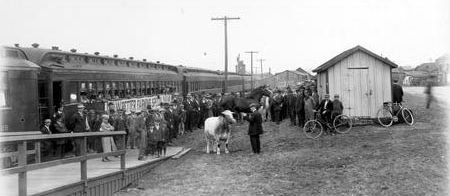 Photo from the Ohio History Central web site, http://www.ohiohistorycentral.org/w/Morrill_Act |
 Agricultural Train in Oregon |
 From the Montana State University Historical Photographs Collection |
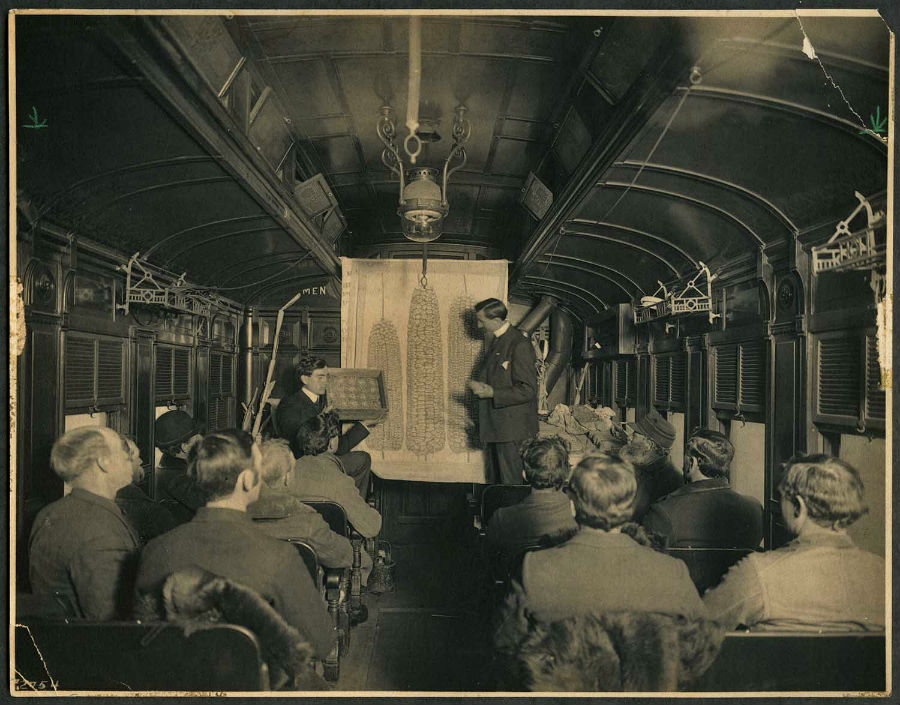 A demonstration train lesson on Corn. Image from Iowa State University Archives |
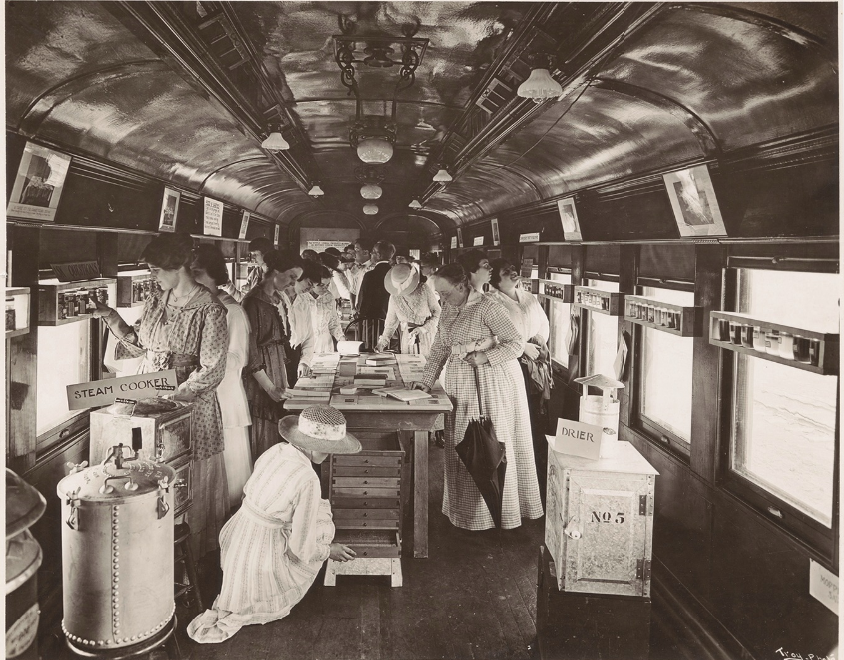 The Home Economics Car. From the Cornell University Library Digital Collection |
 Image from http://www.mhs.mb.ca/docs/features/timelinks/reference/db0080.shtml |
 The band in Aurora, Oregon greeted the agricultural train. https://oregonhistoryproject.org/articles/historical-records/aurora-band-greets-southern-pacific-farm-train/#.W6vOD3tKjRY |
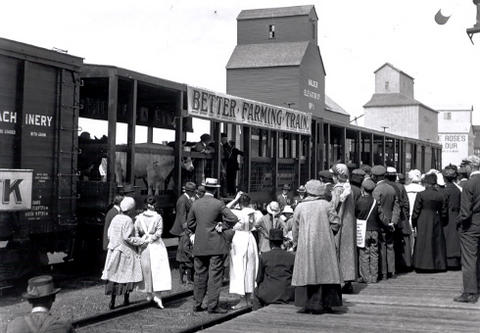 A Canadian demonstration train. University of Saskatchewan Archives, Public Domain, https://commons.wikimedia.org/w/index.php?curid=25297726 |
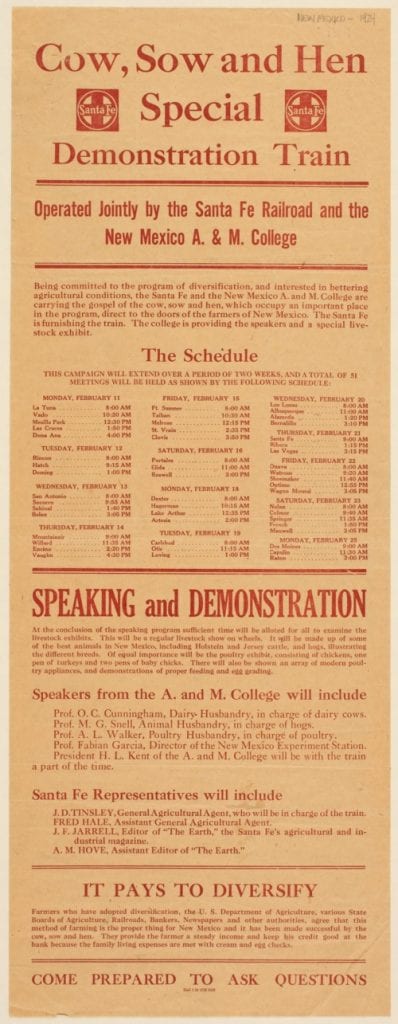 A schedule of demonstration train stops. From the Kansas Historical Society |
Authors Note: Some of the material in this Friday Footnote is based on the work of Jessica Moore, a former student of mine.
Teaching Ideas:
If you teach agricultural communications, the history of agriculture, adoption of technology or extension program planning, there are several uses for this information. You might:
- Have your students do a Google Search to determine if agricultural demonstration trains operated in your state and report on them. You might need to search Google Books or try to locate annual reports of the Extension Service, State Agricultural Societies, Farmers Institutes or State Departments of Agriculture during the 1905-1915 era.
- Have your students assume that Agricultural Trains are going to be revived. What topics or information or exhibits do they think should be featured on the trains?
- Identify methods and approaches that should be used today to communicate new technology to the agricultural community.
- Have your visually oriented students search for images of the agricultural demonstration trains and make observations about the themes that might emerge from analyzing the photos.
- Have your advanced students write an essay about agricultural demonstration trains. To foster higher order thinking they might compare and contrast the agricultural demonstration trains of America, Canada, and Australia.
References:
Clarke, W. T. (1911, January 14). The Agricultural and Horticultural Demonstration Train. The Pacific Rural Press.
Peck, T. F. (1914). Tennessee Agriculture, Vol. 3, No. 1, pages 249-266.
Scott, R. V. (1962). Railroads and Farmers: Educational Trains in Missouri, 1902-1914. Agricultural History, 36(1), 3-15.
Stickley, G. (1910, November 1). Railroads as Aids to Farmers: How the Need for More Traffic has Led Them to Help in the Revival of Agriculture. The Craftsman, 19(2), 186-191.
True, A. C. (1928). A History of Agricultural Extension Work in the United States, 1785 -1923. United States Department of Agriculture, Misc. Publication 15, Washington, DC.
University of Wisconsin.; 32,275 Persons Visit the Agricultural Demonstration Trains. (1913, March 2) The New York Times, 5, 18
